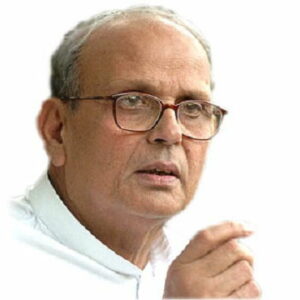Vishwanath Pratap Singh was an Indian politician who was the country’s eighth Prime Minister from 1989 to 1990. During his time as Prime Minister, he worked to ameliorate the plight of India’s lower castes, and he has a significant role in Indian politics. He rose through Indian politics thanks to his sharp sense of judgment and unwavering conviction. Throughout the 1970s and 1980s, he held different important posts in the Indian National Congress administration. He worked hard to cobble together a coalition of the Left parties and the BJP against the Rajiv Gandhi government after resigning as defense minister and leaving the Congress Party due to Rajiv Gandhi’s meddling in his decisions. He built a coalition government with many tiny parties that won the 1989 elections. However, disagreements over religion and caste problems eventually splintered the alliance, and the Bhartiya Janta Party withdrew its support, forcing him to quit. Even though he was only in office for a brief time, he is remembered as a fearless leader who made daring decisions and fought tirelessly to improve the lives of the poor and Dalits.
Childhood and Adolescence
V. P. Singh was born on June 25, 1931, to Raja Bhagwati Prasad Singh and his Rajput Gahawar (Rathore) zamindar family of Daiya. Raja Bahadur Ram Gopal Singh, the king of Manda, adopted him in 1936.
Colonel Brown Cambridge School at Dehra Dun provided him with formal education, and he went on to Allahabad and Pune (Poona) universities to further his study. He was President of the Students Union at Udai Pratap College in Varanasi from 1947 to 1948, and then became Vice President of the Allahabad University Students Union.
Career of V. P. Singh
In 1969, he joined the Indian National Congress Party and was elected to the Uttar Pradesh Legislative Assembly. He became a Member of Parliament in 1971 after winning the Lok Sabha elections. He was elected Union Deputy Minister of Commerce in 1974, and he served as Union State Minister of Commerce from November 1976 to March 1977.
He became the Chief Minister of Uttar Pradesh in 1980, a position he held till 1982. During his term, he worked tirelessly to remove the dacoit problem in Uttar Pradesh’s southwestern region.
In 1983, he returned to the cabinet as Minister of Commerce. He was also in charge of the Department of Supply and was elected to Parliament (Rajya Sabha).
He was elected President of the Uttar Pradesh Congress Committee in September 1984. Prime Minister Rajiv Gandhi nominated him as Union Finance Minister on December 31, 1984, after Indira Gandhi died in October 1984.
He was promoted to Minister of Defense in January 1987 but resigned from Gandhi’s cabinet later that year after his investigations into arms-procurement fraud were quashed. He abruptly resigned from the administration and the Congress Party shortly after.
He founded the ‘Jan Morcha’ opposition party after resigning as a Congress cabinet minister. In a hotly contested by-election in Allahabad, he was re-elected to the Lok Sabha.
Following that, he established the Janata Dal (JD), a coalition of tiny centrist opposition parties including Jan Morcha, Janata Party, Lok Dal, and Congress (S). He quickly created a broader nationwide opposition coalition, the National Front (NF), with the aid of the Janata Dal, which contested the general legislative elections in November 1989 alongside the BJP and the Communist parties.
He was elected Prime Minister of India on December 2, 1989, after the National Front won the elections. His ruling coalition won control of both houses of India’s parliament after state legislative elections in March 1990.
On the advice of the Mandal Commission, he passed a fixed quota reservation for people from the historically disadvantaged “Other Backward Classes” in all public sector employment during his tenure as Prime Minister (OBC). Non-OBC youths in urban areas across North India reacted angrily to this.
When the BJP withdrew its support for the National Front government after its leader L.K. Advani was imprisoned on Singh’s orders during a Rath Yatra supporting the construction of a Ram Mandir in Ayodhya, he was forced to resign. After getting a vote of no confidence in the Lok Sabha, he resigned on November 7, 1990.
Later in life, he traveled to India, giving public lectures and talks on social justice issues while still pursuing his artistic hobbies, particularly painting. He ceased making public appearances after being diagnosed with cancer in 1998.
Personal History and Legacy
He married Sita Kumari, the daughter of the Raja of Deogarh-Madaria in Rajasthan, on June 25, 1955, in an arranged marriage. Ajay Singh, born in 1957, and Abhai Singh, born in 1958, were the couple’s two sons.
He died in Delhi, India, on November 27, 2008, after a protracted battle with multiple myeloma (bone marrow cancer) and renal failure. In Allahabad, he was cremated on the banks of the Ganges River.
V. P. Singh’s Net Worth
The estimated net worth of V. P. Singh is about $700,000.


